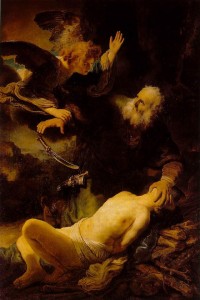Maybe you also have friends who are remarkable artists, talents that their families say began emerging from earliest childhood. Then there are the rest of us who can appreciate art. I long ago reconciled myself to being in the latter category, justifying that someone had to troop through all those galleries and museums oohing and aahing.
When I saw the first Biblically themed painting by Dutch master Rembrandt van Rijn, however, my appreciation was lifted to a new category of reverence. Look at what this master of light and brush strokes glimpsed–often something of the very details I had imagined and pondered in the same Biblical account. We somehow met across the centuries–in New York, London, Paris– or wherever his work was gracing a museum. He, with his inspired insights, and me (joining millions of other viewers) with our gratitude of wonderment for his genius in capturing what before had been in the mind’s eye.
Slowly it began to dawn, after looking at his magnificent work over the past three decades, that he was interpreting the Scriptural text every bit as much as the person whose medium was the written word.
An example of this visual interpretation is Rembrandt’s depiction of that turning point in the book of Genesis when the angel stops Abraham just as he is about to obediently obey God to sacrifice his only son, Isaac. While it is clear the painting is based on Genesis 22, there are certain decisions Rembrandt had to make in his visual retelling.
- Did Isaac go along with the sacrifice or was the boy terrified?
- What was Abraham’s attitude in all this: heartbreak, acquiescence, resolve?
- Was the angel so close Abraham could almost ‘feel’ this symbol of God’s presence?
- And where is God in all this?
The text doesn’t spell all this out so it is left to us – and the artist—to discern.
First, the focal point of the painting is the light on Isaac’s chest, which then takes the viewer up to Abraham’s startled face. Such a registering of surprise hints at how resolute this servant of God was in obediently carrying out the directive to sacrifice his son. Abraham’s shock at the angel’s interruption could communicate just how close the knife must have come to the boy’s exposed throat. And of course the angel’s left hand, literally restraining Abraham, is another way of seeing how the father had to be forcefully stopped, so single-minded was he to carry out God’s order.
How does Rembrandt interpret Isaac’s attitude at this dramatic turn of events, when he is suddenly bound and becomes aware he is the sacrifice instead of an animal? Isaac’s legs are one clue that he was willing to give his life out of love for his father and/or his father’s desire to follow God’s directive. The boy’s body shows he is strong and yet the legs – which could resist – are not stiff and pushing back, especially with the right one open and bent on the ground.
The knife literally falling through the air is a third example of how Rembrandt silently but so powerfully communicates the sense of urgency with which the angel had to move to restrain this father so ready to fulfill a divine directive. Does this tell us how much Abraham loves this son he is willing to kill? Look at how tenderly Abraham shields the boy’s eyes from his imminent death so he doesn’t have to see his father’s final act that will end Isaac’s life.
Genesis 22:17 tells of the angel’s blessing on Abraham’s progeny, so movingly declared by the angelic messenger’s raised hand, with open palm pointing upward. And what about the blue garment underlying Isaac’s body, and how the color is picked up on angel’s sleeve and again in the sky? Is that to unify the major ‘actors’, including perhaps God, represented by the sky?
There is so much to discern and these ideas are only touching the surface. If you like this brief glimpse, you might enjoy a book by Dutch cultural theorist, Mieke Bal, Reading Rembrandt: Beyond the Word-Image Opposition. Meanwhile, please share your insights on this painting in the comments section below.
Join me in offering a Thanksgiving prayer of thanks for Rembrandt’s commitment to interpret the Bible by bringing his enormous repertoire of artistic talents to the task. One wonders if he suspected they were God-given.





Thanks, Madelon. I learned some wonderful insights into how Rembrandt was thinking, and that was a delight. Doug
Loved your interpretation. It opened my eyes to appreciate Rembrant’s artistry and inspiration. I feel the drama of the moment so strongly when I look at this painting. It captures the intensity of Abraham’s resolution and the instantaneous presence of the powerful angel message. I love that the angel is DOING something – literally preventing Abraham from proceeding with his actions. I also am in awe of the quality of the light on Isaac’s body, and the size of Abraham’s hand on his face. This conveys to me immense grief. What a shocking thing for a father to have to… Read more »
Enjoyed your post. Woke this morning thinking about human sacrifice. My 12 y/o is studying human sacrifice in Aztec culture in school. Aztecs simply disappeared w/o trace. Perhaps killed each off jokes son. Indeed the human self must be sacrificed to make room for the spiritual. perhaps the Aztec finally interpreted/got angel message right.